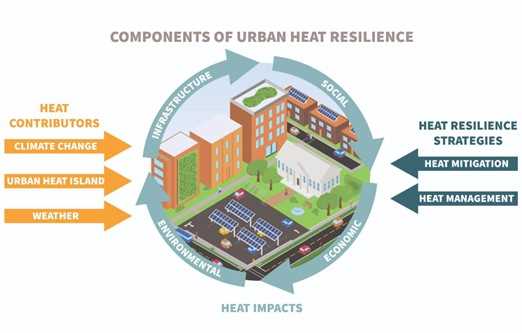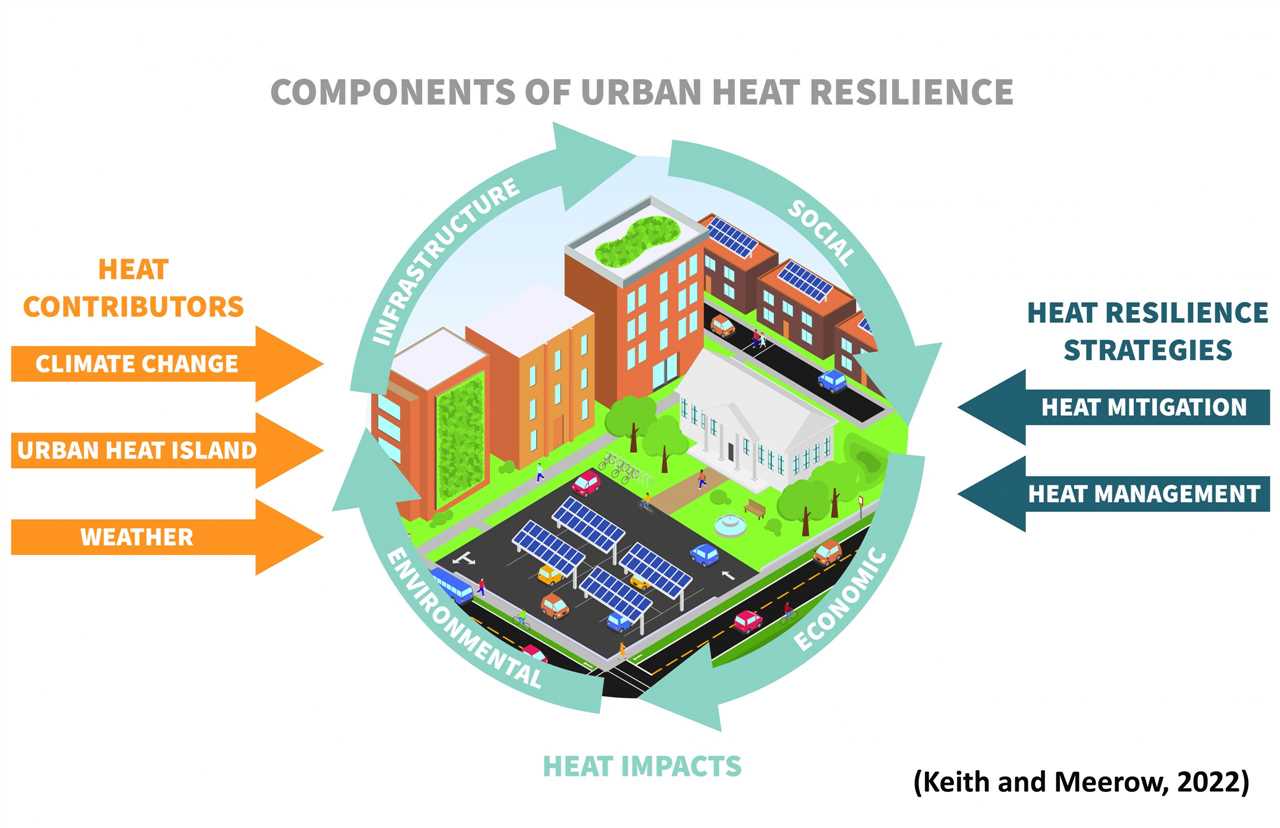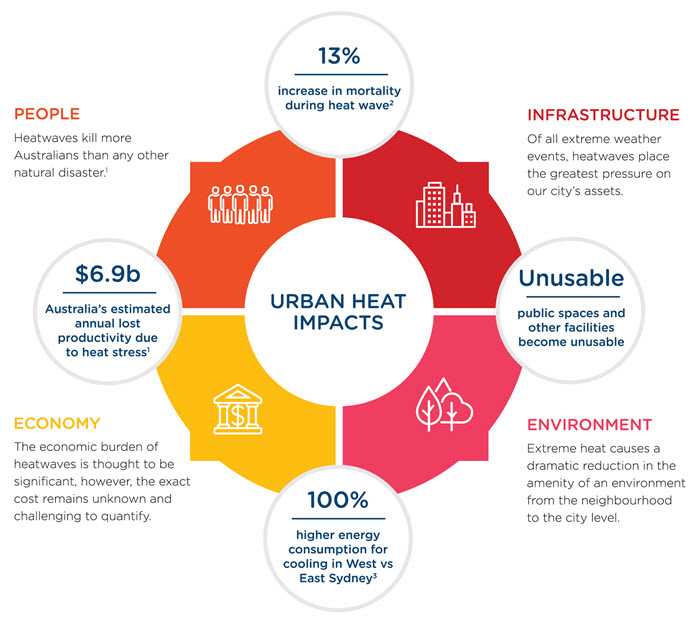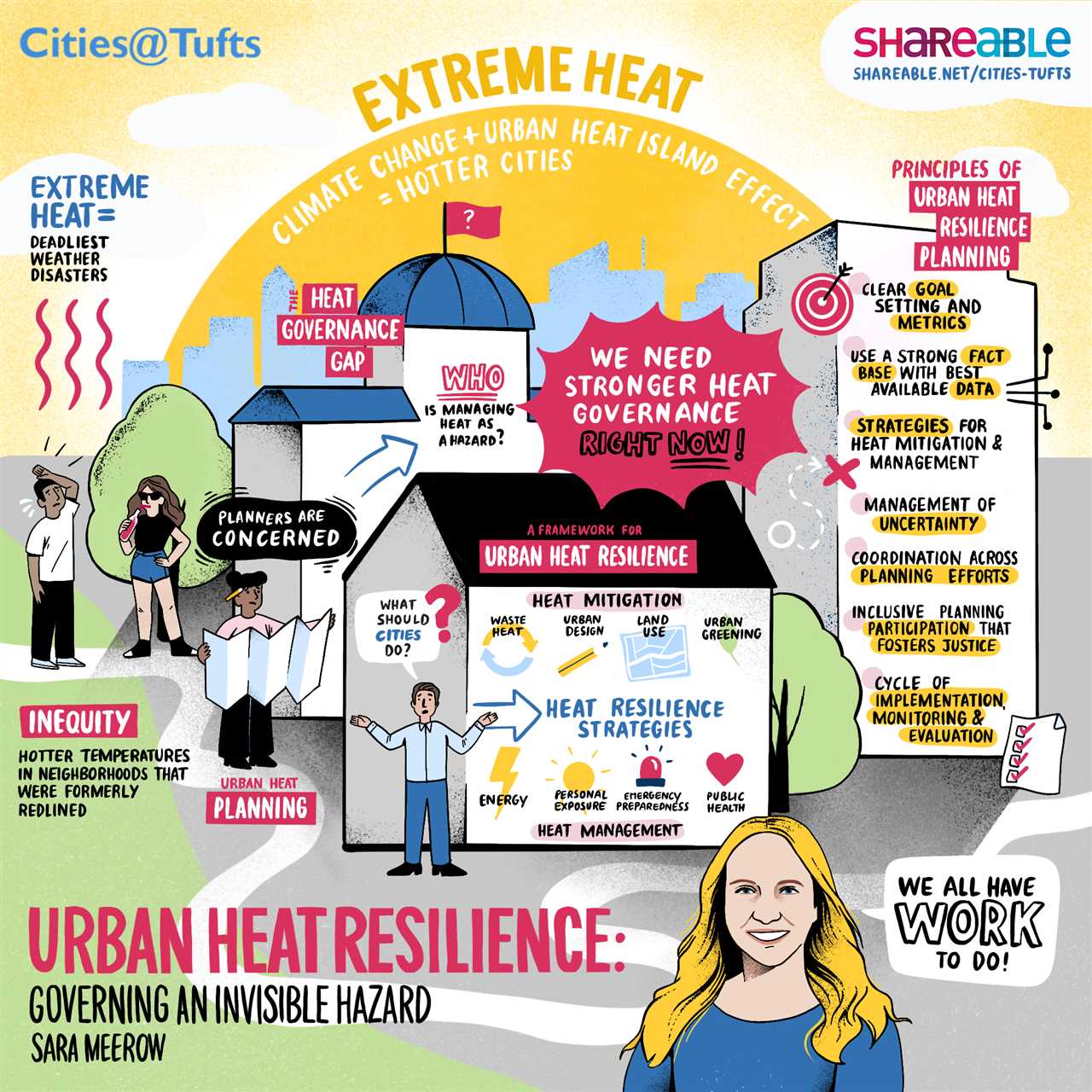
As urban areas continue to grow and face the challenges of climate change, it is crucial to develop policies that enhance resilience to urban heat stress. Urban heat stress refers to the increase in temperature in urban areas due to the concentration of buildings, pavement, and other infrastructure that absorb and retain heat. This phenomenon poses significant risks to public health, particularly for vulnerable populations.
To address this issue, it is essential for policymakers to implement recommendations that prioritize the well-being of urban residents. One of the key recommendations is to increase green spaces in cities. Green spaces, such as parks and gardens, help to reduce urban heat by providing shade and promoting evapotranspiration, which cools the surrounding air. These spaces also offer opportunities for physical activity and social interaction, contributing to overall community well-being.
Furthermore, policymakers should prioritize the implementation of cool roof programs. Cool roofs are designed to reflect more sunlight and absorb less heat compared to traditional roofs. By incentivizing the installation of cool roofs, cities can significantly reduce the urban heat island effect and decrease energy consumption for cooling. These programs can also create job opportunities in the construction and maintenance sectors, contributing to economic growth.
Another important recommendation is the development of urban heat action plans. These plans should include strategies for heatwave early warning systems, public education campaigns, and the establishment of cooling centers in areas with high vulnerability to heat stress. By implementing comprehensive heat action plans, cities can better prepare and respond to extreme heat events, reducing the impact on public health and mortality rates.
In conclusion, enhancing urban heat stress resilience requires the implementation of effective policies. By increasing green spaces, promoting cool roof programs, and developing urban heat action plans, policymakers can create healthier and more resilient cities. These measures not only mitigate the negative effects of urban heat stress but also contribute to overall urban livability and sustainability.
Understanding Urban Heat Stress
Urban heat stress refers to the increase in stress and discomfort experienced by individuals in urban areas due to high temperatures. As cities continue to grow and urbanization intensifies, the urban heat island effect exacerbates the problem, making cities even hotter than their surrounding rural areas.
Heat stress occurs when the body’s ability to regulate its internal temperature is overwhelmed by external heat. This can lead to various health issues, including heat exhaustion and heatstroke. Vulnerable populations, such as the elderly, children, and those with pre-existing medical conditions, are particularly at risk.
Understanding and addressing urban heat stress is crucial for enhancing the resilience of urban communities. By implementing appropriate policies and measures, cities can better protect their residents from the adverse effects of heat stress.
Recommendations for mitigating urban heat stress include increasing green spaces and vegetation, promoting the use of cool materials for urban infrastructure, and improving access to cooling centers and public spaces with shade. These measures can help reduce the urban heat island effect and provide relief to residents during heatwaves.
Furthermore, urban planning and design should prioritize the creation of walkable and bikeable neighborhoods, reducing the reliance on cars and decreasing heat-generating traffic. Enhancing public transportation systems can also contribute to reducing heat stress by reducing the number of vehicles on the road.
Education and awareness campaigns are also essential in helping residents understand the risks of heat stress and the measures they can take to protect themselves. This can include providing information on proper hydration, the importance of staying indoors during peak heat hours, and recognizing the signs of heat-related illnesses.
In conclusion, understanding urban heat stress is crucial for developing effective policies and recommendations to enhance the resilience of urban communities. By implementing measures to mitigate heat stress, cities can create healthier and more livable environments for their residents.
Impact of Urban Heat Stress

Urban heat stress refers to the increased heat levels experienced in urban areas due to the combination of urbanization and climate change. This phenomenon has significant impacts on the health and well-being of urban populations.
The recommendations for addressing urban heat stress are crucial in order to mitigate the negative effects it has on individuals and communities. Heat stress can lead to a range of health issues, including heat stroke, dehydration, and exacerbation of existing medical conditions.
One of the key policy recommendations is to increase the availability of green spaces in urban areas. Trees and vegetation provide shade, reduce temperatures, and improve air quality, making them essential in combating heat stress. Urban planning should prioritize the creation of parks, gardens, and green roofs to provide relief from the heat.
Another important recommendation is to implement cool roof policies. Cool roofs are designed to reflect sunlight and absorb less heat, reducing the temperature of buildings and surrounding areas. By mandating the use of cool roofs in urban areas, cities can significantly decrease the urban heat island effect and mitigate heat stress.
Furthermore, it is essential to enhance the accessibility and affordability of cooling technologies. Air conditioning and other cooling systems can provide relief from heat stress, but they are often expensive and inaccessible to vulnerable populations. Governments should develop policies to make cooling technologies more affordable and ensure equitable access for all residents.
Education and awareness campaigns are also crucial in addressing urban heat stress. Public outreach programs can educate individuals on the risks of heat stress and provide information on how to protect oneself during extreme heat events. This includes promoting the use of sunscreen, staying hydrated, and seeking shelter in cool environments.
In conclusion, the impact of urban heat stress is significant and requires comprehensive policy recommendations to address. By increasing the availability of green spaces, implementing cool roof policies, enhancing accessibility to cooling technologies, and promoting education and awareness, cities can effectively mitigate the negative effects of heat stress and enhance the resilience of urban populations.
Policy Measures for Enhancing Resilience
Enhancing resilience to urban heat stress requires a comprehensive set of policy measures that address various aspects of the issue. The following recommendations aim to increase the capacity of cities to withstand and adapt to heat stress:
- Implement heat action plans: Cities should develop and implement heat action plans that include strategies for heatwave preparedness, early warning systems, and heat health risk communication. These plans should involve collaboration between relevant government agencies, health organizations, and community groups.
- Enhance urban green spaces: Increasing the availability and accessibility of urban green spaces can help reduce the urban heat island effect and provide cooling benefits. Policies should focus on creating and maintaining parks, gardens, and green roofs, as well as preserving existing green areas.
- Promote energy-efficient buildings: Policies should encourage the construction and retrofitting of buildings with energy-efficient designs and technologies. This can include measures such as mandating the use of reflective roofs, improving insulation, and promoting the use of renewable energy sources.
- Improve urban planning: Urban planning policies should prioritize the integration of heat-resilient design principles. This can involve measures such as incorporating shading structures, promoting natural ventilation, and ensuring adequate green spaces and tree cover in new developments.
- Invest in public infrastructure: Policies should prioritize the development of heat-resilient public infrastructure, such as cooling centers, shaded walkways, and water fountains. These measures can provide relief during heatwaves and enhance the overall resilience of cities.
- Advance community engagement: Policies should support community engagement and participation in resilience-building efforts. This can involve initiatives such as community-led heat action groups, educational campaigns, and partnerships with local organizations.
- Integrate heat resilience into health systems: Policies should ensure that health systems are equipped to respond to heat-related health risks. This can include measures such as training healthcare professionals on heat-related illnesses, improving surveillance systems, and providing targeted healthcare services during heatwaves.
By implementing these policy measures, cities can enhance their resilience to urban heat stress and create healthier and more sustainable urban environments.
Urban Planning and Design

Urban planning and design play a crucial role in enhancing urban heat stress resilience. By incorporating specific recommendations and policies, cities can increase their ability to withstand and mitigate the impacts of heat stress.
One key recommendation is to prioritize the integration of green spaces and urban vegetation. Trees and green infrastructure provide shade, reduce the urban heat island effect, and improve air quality. Urban planning should include measures to increase the number and quality of parks, gardens, and green roofs. This will not only enhance the aesthetic value of cities but also provide cooling effects and promote physical and mental well-being.
Another policy recommendation is to promote the use of cool materials and sustainable building design. Heat-reflective surfaces, such as white roofs and pavements, can significantly reduce the absorption of heat and lower ambient temperatures. Additionally, sustainable building design techniques, such as natural ventilation and passive cooling systems, can decrease the reliance on energy-intensive air conditioning and reduce overall heat stress.
Furthermore, urban planning should prioritize the creation of pedestrian-friendly environments. By designing walkable neighborhoods with shaded sidewalks, covered walkways, and street trees, cities can encourage active transportation and reduce the reliance on cars. This not only reduces heat emissions but also promotes physical activity and improves overall public health.
Lastly, urban planning and design should consider the social and economic aspects of heat stress resilience. Vulnerable populations, such as the elderly, children, and low-income communities, are more susceptible to heat stress. Cities should prioritize the equitable distribution of urban amenities, such as shaded public spaces, cooling centers, and affordable housing with proper insulation. Additionally, policies should be implemented to raise awareness and educate residents about heat stress and the importance of adaptation measures.
In conclusion, urban planning and design can significantly contribute to enhancing urban heat stress resilience. By implementing the recommended policies and strategies, cities can increase their ability to withstand and mitigate the impacts of heat stress, creating more sustainable and resilient urban environments.
Green Infrastructure Implementation

Green infrastructure refers to the strategic use of natural and semi-natural elements to mitigate the negative effects of urban heat stress. By incorporating green spaces, such as parks, gardens, and urban forests, into the urban landscape, cities can increase their resilience to heat stress and improve the overall quality of life for their residents.
Implementing green infrastructure policies is essential to address the challenges posed by increasing urban heat stress. These policies should prioritize the creation and maintenance of green spaces in urban areas, particularly in neighborhoods that are most vulnerable to heat stress. By increasing the availability of green spaces, cities can provide residents with cooler and more comfortable environments, reducing the risk of heat-related illnesses and improving overall well-being.
In addition to providing shade and cooling effects, green infrastructure can also help to mitigate the urban heat island effect, which is the phenomenon of urban areas being significantly hotter than surrounding rural areas. By increasing vegetation cover and implementing green roofs and walls, cities can reduce surface temperatures and decrease the demand for air conditioning, thus reducing energy consumption and greenhouse gas emissions.
Furthermore, the implementation of green infrastructure policies can have multiple co-benefits. For example, the creation of green spaces can improve air quality, enhance biodiversity, and provide recreational opportunities for residents. These co-benefits contribute to the overall resilience and sustainability of urban areas.
To effectively implement green infrastructure policies, it is essential to involve multiple stakeholders, including local governments, urban planners, community organizations, and residents. Collaboration and engagement with these stakeholders can ensure that green infrastructure projects are tailored to the specific needs and characteristics of each urban area. Additionally, policy frameworks should provide incentives and support for the private sector to invest in green infrastructure projects.
In conclusion, the implementation of green infrastructure is a crucial policy recommendation for enhancing urban heat stress resilience. By increasing the availability of green spaces and incorporating natural elements into the urban landscape, cities can mitigate the negative effects of heat stress, improve the overall quality of life for residents, and contribute to the sustainability and resilience of urban areas.
Heat Warning Systems and Public Education
Heat stress is a significant problem in urban areas, and its impacts are expected to increase with climate change. To enhance the resilience of cities to heat stress, it is essential to implement effective heat warning systems and educate the public about the risks and protective measures.
A heat warning system is a crucial tool for managing heat stress in urban areas. It involves monitoring meteorological data, such as temperature and humidity, and issuing warnings when heat thresholds are exceeded. These warnings can be communicated through various channels, including weather apps, social media, and public announcements.
Public education plays a vital role in increasing the resilience of urban communities to heat stress. Through targeted campaigns and outreach programs, the public can be informed about the risks associated with heat stress and the actions they can take to protect themselves. This can include staying hydrated, seeking shade, wearing appropriate clothing, and avoiding strenuous outdoor activities during peak heat hours.
Policy initiatives should focus on integrating heat warning systems with public education efforts. This can involve creating partnerships between meteorological agencies, health departments, and community organizations to ensure the effective dissemination of heat warnings and educational materials. Additionally, policymakers should allocate resources to develop and implement educational programs that target vulnerable populations, such as the elderly, children, and individuals with pre-existing health conditions.
By implementing comprehensive heat warning systems and educating the public about heat stress, urban areas can increase their resilience to extreme heat events. These policy recommendations can help cities mitigate the impacts of heat stress and ensure the well-being of their residents, especially during periods of high heat.
Policy Implementation Challenges
Implementing policies to enhance urban heat stress resilience presents several challenges. These challenges must be addressed to ensure the effective implementation of recommendations to mitigate the impact of heat stress in urban areas.
- Lack of awareness: One of the main challenges is the lack of awareness among policymakers and stakeholders about the importance of addressing urban heat stress. There is a need to increase awareness about the potential risks and impacts of heat stress in urban areas and the need for policy action.
- Policy coordination: Another challenge is the coordination of policies across different sectors and levels of government. Urban heat stress resilience requires a multi-sectoral approach involving various stakeholders, including local governments, urban planners, health authorities, and community organizations. Coordinating efforts and aligning policies can be complex but is crucial for effective implementation.
- Financial constraints: Implementing policy recommendations often requires financial resources. However, many urban areas may face financial constraints, limiting their ability to invest in heat stress mitigation measures. Finding innovative financing mechanisms and securing funding sources are essential to overcome this challenge.
- Political will: Policy implementation requires political will and leadership. However, prioritizing urban heat stress resilience may compete with other pressing political priorities. Building political support and commitment to address heat stress is crucial for policy implementation.
- Data availability and quality: Effective policy implementation relies on accurate and up-to-date data on urban heat stress. However, data availability and quality can be a challenge in many urban areas. Improving data collection, monitoring, and analysis systems is essential to inform policy decisions and track progress.
Addressing these challenges is essential to ensure the successful implementation of policy recommendations and to increase urban heat stress resilience. By overcoming these obstacles, policymakers can create more livable and sustainable urban environments for all residents.
Financial Constraints
One of the main challenges in implementing policies to enhance urban heat stress resilience is the financial constraints faced by cities. The cost of implementing measures to mitigate the heat stress and increase resilience can be significant, and many cities may struggle to allocate sufficient funds for these initiatives.
However, it is crucial for cities to prioritize and allocate resources to address urban heat stress, as the impacts of heat stress can be severe and long-lasting. Investing in measures to increase resilience can help reduce the negative effects of heat stress, such as heat-related illnesses, increased energy consumption, and reduced productivity.
To overcome financial constraints, cities can consider the following recommendations:
| 1. Seek external funding: | Cities can explore opportunities for securing external funding from national or international sources. This can include grants, loans, or partnerships with organizations that have a vested interest in promoting urban heat stress resilience. |
| 2. Prioritize funding: | Cities should prioritize funding for initiatives that have the greatest potential to increase resilience and mitigate heat stress. This can be done through a thorough assessment of the city’s vulnerabilities and the identification of cost-effective measures that can yield significant benefits. |
| 3. Public-private partnerships: | Cities can explore partnerships with private entities to share the financial burden of implementing resilience measures. This can include collaborations with businesses, developers, or utility companies that can contribute resources or funding in exchange for benefits such as increased property value or improved public image. |
| 4. Innovative financing mechanisms: | Cities can explore innovative financing mechanisms, such as green bonds or impact investing, to fund resilience initiatives. These mechanisms can attract private investment by offering financial returns while also addressing environmental and social challenges. |
By addressing financial constraints and allocating adequate resources, cities can enhance their urban heat stress resilience and create more livable and sustainable environments for their residents.

I am Patrina de Silva, a psychologist and mental health blogger in Sri Lanka. After obtaining psychology degrees from the University of Colombo and Monash University, I returned home to work as a counselor while also starting the popular blog “Pressy but Happy” to provide advice on psychological issues. Over the past decade, my empathetic articles have made my blog a leading mental health resource in the country. In addition to writing, I maintain a private therapy practice, frequently volunteer counseling time, and conduct seminars, driven by my passion for destigmatizing mental illness and educating the public on the mind-body connection. I strive to be an influential voice in my field through my compassionate approach.
